story and photos by Kayte Deioma
Whereas the other three museums are very Southwest oriented, this unprecedented collection of international folk art seems to have found an unlikely home in this high desert capital of about 65,000 inhabitants. As the beneficiary of two extensive personal folk art collections, Santa Fe’s Museum of International Folk Art now has the most extensive folk art collection in the world.
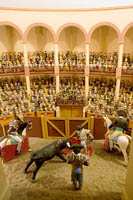 The Girard Wing contains a small sample of the 100,000 pieces donated by famed architect and designer Alexander Girard, who also designed the exhibit, Multiple Visions: A Common Bond, which is the definition of delightful. 10,000 colorful folk-art figures that he and his wife collected from 100 different countries on six continents are displayed in a context of miniature rooms, houses, churches, castles, villages and towns. Each display is a treat to behold. Hundreds of tiny spectators watch a bullfight in “Plaza de Toros”. Musicians play and uniformed cavalry ride as dozens of miniature pilgrims climb a long staircase in a display of 1930s decorative ceramics by Ana Das Telas and three other women from Estremoz, Portugal.
The Girard Wing contains a small sample of the 100,000 pieces donated by famed architect and designer Alexander Girard, who also designed the exhibit, Multiple Visions: A Common Bond, which is the definition of delightful. 10,000 colorful folk-art figures that he and his wife collected from 100 different countries on six continents are displayed in a context of miniature rooms, houses, churches, castles, villages and towns. Each display is a treat to behold. Hundreds of tiny spectators watch a bullfight in “Plaza de Toros”. Musicians play and uniformed cavalry ride as dozens of miniature pilgrims climb a long staircase in a display of 1930s decorative ceramics by Ana Das Telas and three other women from Estremoz, Portugal.
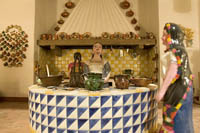 Women in Mexican garb make tiny enchiladas on a horseshoe shaped counter in a kitchen filled with miniscule clay pots, tin utensils and copper pans hanging above the brazero fireplace. Girard created the display based on a colonial kitchen he had seen in Mexico. A door off of the kitchen leads to a sala where a man plays a violin and light shines in from an interior courtyard.
Women in Mexican garb make tiny enchiladas on a horseshoe shaped counter in a kitchen filled with miniscule clay pots, tin utensils and copper pans hanging above the brazero fireplace. Girard created the display based on a colonial kitchen he had seen in Mexico. A door off of the kitchen leads to a sala where a man plays a violin and light shines in from an interior courtyard.
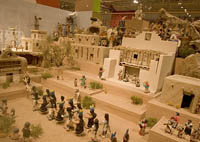 In “Pueblo Feast Day,” children play among adobe houses and tourists take photos as adult figures dance the corn dance below with kachina spirit dancers and eagle dancers on the mesa above. This exhibit contains the most famous piece of art in the gallery. Helen Cordero, a Cochiti Indian and Alexander Girard collaborated on the design of the first “storyteller” figure created by a New Mexico Pueblo artist. “Storyteller” figures of a seated woman with multiple children sitting or climbing on her have become ubiquitous in earthenware work.
In “Pueblo Feast Day,” children play among adobe houses and tourists take photos as adult figures dance the corn dance below with kachina spirit dancers and eagle dancers on the mesa above. This exhibit contains the most famous piece of art in the gallery. Helen Cordero, a Cochiti Indian and Alexander Girard collaborated on the design of the first “storyteller” figure created by a New Mexico Pueblo artist. “Storyteller” figures of a seated woman with multiple children sitting or climbing on her have become ubiquitous in earthenware work.
Scores of colorful clay figures from two to six inches tall populate a ” Mexican Village” created to represent the village of Puebla. The town has cathedrals in varying sizes to match its multi-sized population. Many of the larger pieces were made by Herón Martinez Mendoza, one of Mexico’s most respected potters from Acatlan, a pottery making center.
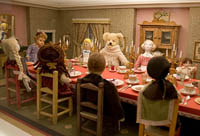 In “Doll’s Christmas Lunch” a teddy bear in a turtleneck and a couple pilgrims sit down to a fancy dinner with the other assorted interntaional residents of a Victorian doll house. East Indian puppets from Rajastan with black beards and mustaches painted on their carved wooden heads mingle with various Hindu gods and mythological figures in and around a multi-storied palace in “Indian Street Scene.” The marionettes are draped in elaborate gilded costumes.
In “Doll’s Christmas Lunch” a teddy bear in a turtleneck and a couple pilgrims sit down to a fancy dinner with the other assorted interntaional residents of a Victorian doll house. East Indian puppets from Rajastan with black beards and mustaches painted on their carved wooden heads mingle with various Hindu gods and mythological figures in and around a multi-storied palace in “Indian Street Scene.” The marionettes are draped in elaborate gilded costumes.
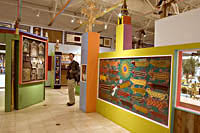 These vibrant daily-life and story-book scenes are interspersed with displays of masks, toys, paintings, costumes, ornate woven story panels and other colorful textiles, providing a constant flow of eye-candy. There are no captions on the displays, so be sure to pick up the spiral-bound guide to the Girard exhibit available at the entrance to be able to identify specific displays.
These vibrant daily-life and story-book scenes are interspersed with displays of masks, toys, paintings, costumes, ornate woven story panels and other colorful textiles, providing a constant flow of eye-candy. There are no captions on the displays, so be sure to pick up the spiral-bound guide to the Girard exhibit available at the entrance to be able to identify specific displays.
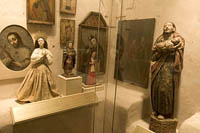 Another permanent exhibit is the Familia y Fe/Family and Faith exhibit in the Hispanic Heritage Wing. The exhibit features pieces from the Museum’s New Mexico Hispanic folk art collection including religious and household objects. The artistry of furniture making and woven textiles are juxtaposed with the religious retablos (paintings) andbultos (wooden sculptures) that have been used both in the home and for ceremonial purposes since the 17 th century.
Another permanent exhibit is the Familia y Fe/Family and Faith exhibit in the Hispanic Heritage Wing. The exhibit features pieces from the Museum’s New Mexico Hispanic folk art collection including religious and household objects. The artistry of furniture making and woven textiles are juxtaposed with the religious retablos (paintings) andbultos (wooden sculptures) that have been used both in the home and for ceremonial purposes since the 17 th century.
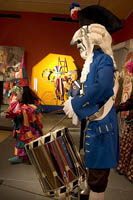 Through August 2005, the Museum is hosting the traveling exhibit ĄCARNAVAL! About 50 festively costumed manikins step out of life-size photos representing select carnival traditions of Bolivia, Brazil, Italy, Mexico, Spain, Switzerland, Trinidad and Tobago and the USA. Accompanying video clips of the each celebration bring the tableaus alive.
Through August 2005, the Museum is hosting the traveling exhibit ĄCARNAVAL! About 50 festively costumed manikins step out of life-size photos representing select carnival traditions of Bolivia, Brazil, Italy, Mexico, Spain, Switzerland, Trinidad and Tobago and the USA. Accompanying video clips of the each celebration bring the tableaus alive.
The Museum and other local arts 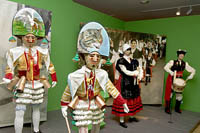 and entertainment organizations are hosting a variety of carnival-themed events throughout the exhibit. Highlights include a Brazilian entertainment weekend at the Museum June 25-26, a Swiss Carnival weekend July 23-24 and a Mexican weekend August 13-14. For more related events including music, arts and crafts workshops and cooking classes visitwww.carnivalsantafe.com.
and entertainment organizations are hosting a variety of carnival-themed events throughout the exhibit. Highlights include a Brazilian entertainment weekend at the Museum June 25-26, a Swiss Carnival weekend July 23-24 and a Mexican weekend August 13-14. For more related events including music, arts and crafts workshops and cooking classes visitwww.carnivalsantafe.com.
There is a children’s playroom near the lobby of the Museum where kids can play while parents explore the touch-me-not displays. I didn’t have time to go downstairs where adults can get hands-on with some of the items in the Museum’s collection.
The pilgrimage to the Museum of New Mexico continues: Museum of Fine Arts, The Museum of Indian Arts and Culture and The Palace of the Governors.
For more information on the Museum of International Folk Arts, visit www.moifa.org.

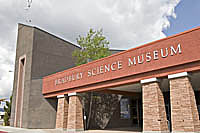 Whether you’re pro or anti, the history of the secret community of scientists who gathered in Los Alamos New Mexico during WWII to develop the first atomic bomb can’t help but fascinate. About 35 miles up the mountain from Santa Fe, the Los Alamos National Laboratory is still on the cutting edge of scientific research. The Lab isn’t generally open to the public, but the Bradbury Science Museum in the town of Los Alamos gives an overview of the Lab’s history and its current research.
Whether you’re pro or anti, the history of the secret community of scientists who gathered in Los Alamos New Mexico during WWII to develop the first atomic bomb can’t help but fascinate. About 35 miles up the mountain from Santa Fe, the Los Alamos National Laboratory is still on the cutting edge of scientific research. The Lab isn’t generally open to the public, but the Bradbury Science Museum in the town of Los Alamos gives an overview of the Lab’s history and its current research.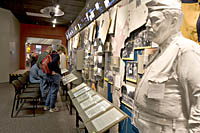 A short video gives the history of the creation of the National Science Laboratory during WWII and another on its current research. A History Gallery provides additional documents, photos, and videos on the Manhattan Project, the scientists involved and life in the secret scientific community that went nameless until after the war.
A short video gives the history of the creation of the National Science Laboratory during WWII and another on its current research. A History Gallery provides additional documents, photos, and videos on the Manhattan Project, the scientists involved and life in the secret scientific community that went nameless until after the war.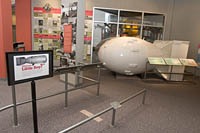 The Defense Gallery focuses on the National Security functions of the Lab and what it does to ensure the safety of existing “nuclear deterrents.” This exhibit has a “Fat Man” bomb casing identical to the one dropped on Nagasaki as well as various other missile casings. There is also an exhibit about where plutonium comes from, its risks and what measures are taken to dispose of it safely. There are a variety of interactive exhibits, including a biometric security turnstile, where you can scan an ID card (provided) and use your hand print to get through the security gate.
The Defense Gallery focuses on the National Security functions of the Lab and what it does to ensure the safety of existing “nuclear deterrents.” This exhibit has a “Fat Man” bomb casing identical to the one dropped on Nagasaki as well as various other missile casings. There is also an exhibit about where plutonium comes from, its risks and what measures are taken to dispose of it safely. There are a variety of interactive exhibits, including a biometric security turnstile, where you can scan an ID card (provided) and use your hand print to get through the security gate.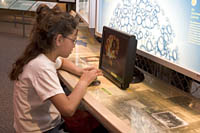 In the Research Gallery, you can learn about the human genome, space science research, radiation, lasers and other ongoing Laboratory research. The exhibits are designed for school-age children through adults. Admission is free. Many of the exhibits are interactive.
In the Research Gallery, you can learn about the human genome, space science research, radiation, lasers and other ongoing Laboratory research. The exhibits are designed for school-age children through adults. Admission is free. Many of the exhibits are interactive.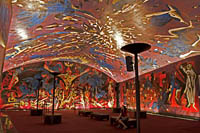 by French artist Jean-Claude Gaugy in an abandoned high school gymnasium in West Virginia, the piece is a series of 400 carved and painted wood panels that cover 8,000 square feet of walls and ceiling. The work was transported in 2002 from West Virginia to its current home in Santa Fe, where Gaugy has his summer studio. The Awakening expresses Gaugy’s spiritual development and connection with the divine.
by French artist Jean-Claude Gaugy in an abandoned high school gymnasium in West Virginia, the piece is a series of 400 carved and painted wood panels that cover 8,000 square feet of walls and ceiling. The work was transported in 2002 from West Virginia to its current home in Santa Fe, where Gaugy has his summer studio. The Awakening expresses Gaugy’s spiritual development and connection with the divine.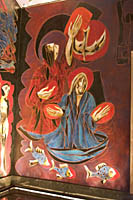 The entrance fee of $3 or a can of food entitles you to a 10 minute audio tour of the artwork. Comfortable padded benches allow you to sit and contemplate the walls or lie on your back to study the ceiling. The central figure on the vaulted ceiling is an abstract medallion of light, color and angles that Gaugy created to symbolize “the inexpressible power and creativity of God, without reference to any specific institutionalized religious belief.” The medallion is surrounded by seeking figures turned toward and away from the light. The wall panels depict Gaugy’s interpretation of various biblical and other religious themes including the four horsemen of the apocalypse, the last supper, Christ’s resurrection and St. Francis ringed with birds and animals
The entrance fee of $3 or a can of food entitles you to a 10 minute audio tour of the artwork. Comfortable padded benches allow you to sit and contemplate the walls or lie on your back to study the ceiling. The central figure on the vaulted ceiling is an abstract medallion of light, color and angles that Gaugy created to symbolize “the inexpressible power and creativity of God, without reference to any specific institutionalized religious belief.” The medallion is surrounded by seeking figures turned toward and away from the light. The wall panels depict Gaugy’s interpretation of various biblical and other religious themes including the four horsemen of the apocalypse, the last supper, Christ’s resurrection and St. Francis ringed with birds and animals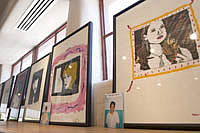 If it’s not raining, the meditation garden is a pleasant place to spend some quiet time. There is also a great book and gift shop which sometimes features the art of participants in the Museum’s youth outreach programs.
If it’s not raining, the meditation garden is a pleasant place to spend some quiet time. There is also a great book and gift shop which sometimes features the art of participants in the Museum’s youth outreach programs.